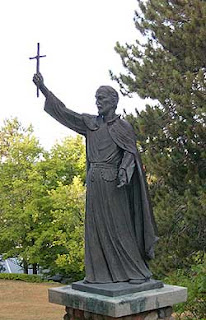
William Henry Judge was born into a religious family in Baltimore, Maryland, April 28, 1850. In addition to William, four of his siblings also entered Holy orders.
As a youth, he was frail and sickly, but he survived, and at age 25, he embarked on years of study and teaching, in the Jesuit order. At the age of 40, in 1890, he volunteered for service in Alaska.
After a lengthy journey which lasted several months, he arrived at Holy Cross Mission, the principal Jesuit centre on the Yukon River, where he joined the Father Superior, two brothers, and three Sisters of St. Ann, who taught fifty resident school children.
Judge had acquired many useful skills before he became a priest: carpenter, cabinet-maker, blacksmith and baker. Later, at Nulato he spent his time teaching native children in their own language, constructing a church, and travelling widely to visit both whites and natives in a large region. Here he had established himself happily and was content with his assignment. From there he was sent to the small mining town of Forty Mile, hundreds of miles up the Yukon River from Nulato.
His fortitude was tested at Forty Mile, where he alone served the spiritual needs of the Catholic community. Father Judge noted: “…everybody is looking for gold, some finding it and some getting nothing, a few becoming rich, but the greater number only making a living, and all working very, very hard. You would be astonished to see the amount of hard work that men do here in the hope of finding gold… Oh if men would only work for the kingdom of heaven with a little of that wonderful energy, how many saints we would have.”
In March 1897, Father Judge went to Dawson and secured 3 acres of land near the north end of town. Once he was settled there, he set about building a church, a residence, and a hospital. The hospital was completed August 20th, 1897.
With harsh climate, poor nutrition and deplorable sanitation conditions in the new town, the hospital was in immediate demand. He was soon tending to 20 patients a day, which rose to 50 during the winter, then, with the influx of humanity and typhoid epidemic in the fall of 1898, 135 patients daily. This dramatic increase made necessary the construction of an addition to the hospital.
For two years, he worked without thought or concern for himself, devoted solely to the care of others. Worn out and exhausted by his own labors, in early January of 1899, he fell ill and for days battled pneumonia, finally succumbing at the age of 52, on January 16 1899.
When Father Judge died, the sadness was shared by the entire community, regardless of religious persuasion. His contributions to the community were widely recognized, as was his spiritual work. He was indeed a hero of the Klondike and is known as the “Saint of Dawson.”
At the north end of Dawson today you will find a quiet clearing overlooking the Yukon River near where his great works were performed. It is here that his grave is found, and nearby, a plaque, mounted on a huge block of stone by the people of Canada, which recognizes his contribution to the physical and spiritual well-being of the miners.
Michael Gates in an article for the City of Dawson history webpage; Pierre Berton; Charles Judge: An American Missionary – A record of the work of the Rev. William A. Judge, S.J. Catholic foreign Missionary Society, Ossining, NY; Mills.

